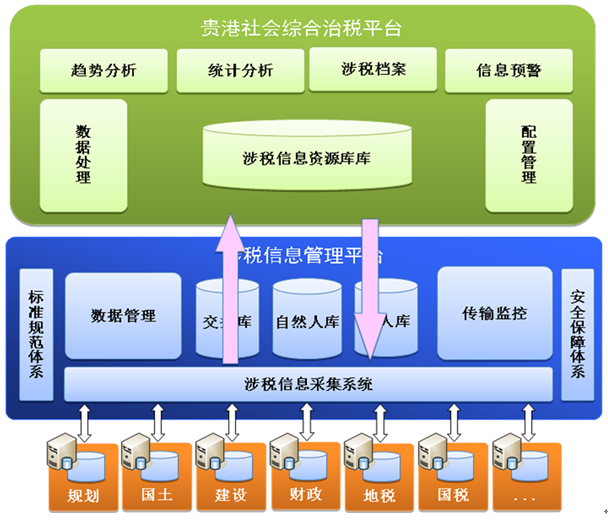Comprehensive Tax Management Information Resource Sharing System
Published: 2016-03-25
Background
Comprehensive social tax management is a system that, under the unified organization, coordination, and guidance of the government, focuses on strengthening tax source control and aims to create a legal, fair, and orderly tax environment. It gradually establishes a comprehensive social tax management system with "government leadership, tax authority supervision, departmental cooperation, judicial protection, social participation, and information technology support" as its main components. Currently, unclear tax sources, asymmetric information between tax collectors and payers, and ineffective monitoring are the main causes of tax revenue loss. By leveraging social forces, using various methods and effective forms, establishing tax source information transmission or sharing systems, and forming a tight monitoring network, we can effectively control tax sources through important scientific means. Vigorously promoting comprehensive social tax management and advancing the construction of a citywide social comprehensive tax management information resource sharing application system are important measures to improve tax collection and management levels, strengthen tax source control, and promote fiscal revenue growth in the new situation. It is an inevitable choice to implement tax work according to law.
.jpg)
Objectives
1. Promote comprehensive social tax management and tap into fiscal revenue growth potential. Relying on the tax-related information exchange platform, further improve the comprehensive social tax management working mechanism, enhance the comprehensive social tax management work network, achieve interconnection and sharing of tax-related information among relevant departments, ensure timely transmission, create a legal, fair, and orderly tax environment, and ensure stable growth of fiscal revenue.
2. Strengthen seamless tax source control and plug tax collection loopholes. Relying on the tax-related information exchange platform, fully integrate tax-related information, establish data application models, focus on promoting departmental collaborative control of tax sources, minimize tax revenue loss to the greatest extent, and ensure all receivable taxes are collected.
3. Strengthen the value-added utilization of tax source information and improve the level of auxiliary decision-making consultation. Relying on the tax-related information exchange platform, strengthen the analysis of taxpaying status, industrial structure, tax source distribution, tax contribution, and other information to provide scientific and detailed reference for government macroeconomic management and decision-making.
Overall Solution

Intelligent Information Collection
Using computer software technology, information is monitored in real-time for customized target data sources. Information matching set tax-related keywords is collected, extracted, mined, and processed, and network information is converted into database structured information saved to the local database. For example, tax-related information is scientifically classified into property rights (equity) transfer information, equity reduction information, corporate merger and reorganization information, commercial housing opening information, corporate financing information, etc. On this basis, using network search technology, tax-related keywords such as "equity, asset restructuring, mergers and acquisitions, auctions, debt repayment" are established to achieve automatic capture of tax-related information from specific websites.
Tax Source Monitoring and Analysis
Full-process tracking of key projects and key enterprises in the city to understand tax revenue changes and provide a basis for economic policy adjustments. The system automatically logically associates the collected tax source information with the local tax collection and management database information and performs intelligent comparison. For successfully matched tax-related information, automatic alerts are provided, tracking and monitoring are performed, tax payments are organized and deposited, and results are fed back, achieving integrated management of tax-related information.
Tax Correlation Analysis
By analyzing macro tax burden, industry tax burden, key tax source tax burden, tax elasticity, etc., understand the macroeconomic conditions and development of the local region.
Tax Forecast Analysis
Conduct tax mining on projects or industries of interest to estimate the future revenue contribution to local finance.
Project Benefits
Strengthen Seamless Tax Source Control and Plug Tax Collection Loopholes
Relying on the tax-related information exchange platform, fully integrate tax-related information, establish data application models, focus on promoting departmental collaborative control of tax sources, minimize tax revenue loss to the greatest extent, and ensure all receivable taxes are collected.
Clarify Economic Trends and Scientifically Formulate Tax Policies
The aggregate information provided by different tax-related departments cannot be directly used to compare the declaration of a specific taxpayer, but tax authorities can use this data as a reference. By employing regression analysis, base period analysis, and other mathematical statistical methods, combined with enterprise financial data and tax data, they can scientifically predict tax revenue development trends. Through horizontal comparison with tax authorities at the same level, they can judge the overall collection and management situation of their unit from a macro perspective, using objective data to assist tax decision-making.
Enhance Information Integration and Meet System Integration Needs
Tax-related data is transmitted through the network, ensuring the authenticity and integrity of first-hand information, facilitating queries, and avoiding the disadvantages of manual file management such as susceptibility to damage, alteration, loss, environmental unfriendliness, and high costs.
Client Feedback
Strengthened tax source control. Relying on the tax-related information exchange platform, a large amount of valuable information has been collected. This has transformed previously hidden and potential tax sources into actual tax sources, and possibly lost tax sources into actual revenue, effectively plugging collection and management loopholes and eliminating blind spots. A comprehensive, three-dimensional tax source management network has been constructed, expanding tax source control from a few specific administrative departments to all departments and units related to tax source management, effectively strengthening tax source control.